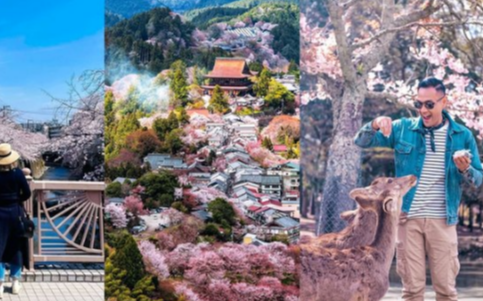Cruising Through Japan’s Seasons from Cherry Blossoms to Autumn Leaves

Japan is a country defined by its seasons. Each time of year brings a distinct personality to the landscape—delicate sakura blossoms in spring, vibrant fireworks and festivals in summer, fiery red maples in autumn, and serene snow-covered temples in winter. For travelers seeking to experience this transformation without the constant repacking and hotel hopping, cruising through Japan offers a convenient and visually rich way to explore the archipelago’s seasonal shifts.
From the deck of a ship gliding along the Pacific coastline or docking in historic port cities, travelers are offered front-row seats to Japan’s natural beauty and centuries-old traditions. Because the country is composed of multiple islands stretching from the snowy north of Hokkaido to the subtropical south of Okinawa, the range of climates means you can chase the bloom of cherry blossoms or the descent of fall colors from one region to another over the course of a single journey.
Spring: The Season of Sakura
Spring in Japan is synonymous with cherry blossoms. From late March through April, parks, riverbanks, temples, and even highways are lined with blooming cherry trees. Cruising this time of year often includes stops in cities like Tokyo, Kyoto (via Osaka or Kobe port), and Hiroshima, each known for its hanami (flower-viewing) spots.
One of the highlights of cruising in spring is that you can follow the bloom northward. Since the sakura season begins in the southern regions and moves north over several weeks, ships traveling up the coast allow guests to witness multiple bloom stages. The iconic view of Himeji Castle framed by pink blossoms or the riverside petals fluttering in Kanazawa’s Kenrokuen Garden make the season unforgettable.
Springtime in Japan also features cultural events like the Takayama Spring Festival and Kyoto’s Miyako Odori dances, both accessible through shore excursions or guided city visits. Many Japanese cruise itineraries during this season are designed with this natural rhythm in mind, offering curated stops at key seasonal destinations.
Summer: Vibrancy and Festivals
While summer brings warmth and humidity, it also introduces Japan’s most energetic season, filled with matsuri (festivals), fireworks displays, and evening food markets. Ports such as Yokohama, Nagasaki, and Aomori serve as gateways to Japan’s cultural exuberance.
In the summer months, cruising allows passengers to comfortably travel between regions that host some of the nation’s biggest festivals without enduring the stress of cross-country train rides in peak heat. For example, docking near Aomori in early August might align with the Nebuta Festival, featuring giant illuminated floats parading through the streets. In Kobe or Osaka, travelers can witness fireworks festivals that light up the harbor skies, often watched from the ship’s upper decks with panoramic views.
Summer also opens access to Japan’s remote islands. Some itineraries extend to Okinawa and the subtropical Yaeyama Islands, offering a mix of snorkeling, pristine beaches, and unique Ryukyuan culture. This contrast between the northern festivals and southern tropical retreats underscores the diversity of Japan’s geography and traditions.
Autumn: A Symphony of Color
As the intense summer heat fades, Japan becomes a patchwork of autumn hues. From mid-October through early December, the country is transformed by brilliant reds, oranges, and golds as maple, ginkgo, and cherry trees turn with the season.
Cruising during autumn offers a scenic passage through Japan’s most picturesque landscapes. The Kyoto and Nara areas—reachable from Osaka or Kobe ports—are among the most photographed locations for fall foliage. Arashiyama’s mountain views, the temples of Kiyomizudera and Tōfuku-ji, and the Philosopher’s Path all become mesmerizing in their autumnal glow.
In the north, Aomori and Hokkaido’s national parks deliver more rustic and dramatic vistas, such as the Oirase Gorge and the volcanic mountains near Lake Toya. These are often included on cruise itineraries that explore Japan’s less-touristed regions, giving guests an immersive look into the quieter side of the country.
Autumn also coincides with harvest festivals and seasonal cuisine. Local specialties—like roasted chestnuts, matsutake mushrooms, and dishes made with new rice—are featured in port town eateries and even on board ships offering Japanese menus.
Winter: Tranquility and Snow-Covered Temples
Though less common for tourists, winter in Japan has its own quiet magic. Snowfall softens temple rooftops and mountain villages, hot springs steam under icy skies, and regional comfort foods like oden and ramen warm travelers from within.
Winter cruises along Japan’s coast, especially around the Sea of Japan, can offer views of snow-capped mountains meeting the ocean and visits to areas famous for their hot spring culture, such as Beppu or Hakodate. For those seeking serenity and fewer crowds, this season delivers a peaceful atmosphere rarely associated with Japan’s more hectic tourist months.
Many itineraries also include New Year celebrations—one of Japan’s most important holidays—offering travelers a chance to witness shrine visits, traditional decorations, and seasonal customs like mochi-pounding and special osechi-ryori meals.
Why Cruises Suit Seasonal Travel in Japan
Japan cruises provide a compelling way to experience the country’s diverse seasons without the complexity of navigating its intricate rail systems or planning multi-city accommodations. The ability to unpack once and wake up in a new region—perhaps one day in Kyoto, the next in Kochi or Kanazawa—means more time spent enjoying the scenery and less on logistics.
While many travelers opt for land-based travel, those who choose a Japan cruise often find that it offers a broader, more comfortable perspective on the country’s natural and cultural shifts. Seasonal sailings are carefully timed to align with the best viewing windows for blossoms or foliage, and many cruise lines now offer enrichment programs on board, from sake tastings to calligraphy workshops, deepening the connection to each destination.
Ultimately, cruising through Japan’s seasons is not just about watching the scenery change from a ship’s deck—it’s about immersing oneself in a cycle of beauty that the Japanese have celebrated for centuries. Whether drawn by the poetic falling of sakura petals or the crisp air of an autumn mountain walk, travelers will find each season holds its own timeless appeal.




